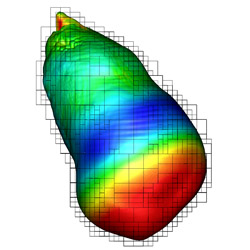ACADEMIA
Blue Waters visualization team provides first science images
With the first portion of the Blue Waters petascale supercomputer now being used by six science teams, the Blue Waters visualization team is using scalable visualization software to produce some of the first science images from the Blue Waters project.
NCSA staff members are performing application tests to ascertain Blue Waters' system and application performance. These tests, done in collaboration with the early science users, have produced datasets that are in turn being used by the Blue Waters visualization staff to test scalable visualization tools. Such tools enable science teams to explore the very large volumes of data they will produce on the full Blue Waters system. While the early visualization work is mostly concerned with software functionality, it is providing tantalizing glimpses of the early science.
NCSA staff members have been collaborating with the science teams since the National Science Foundation made the initial Petascale Computing Resource Allocation (PRAC) awards; these awards enable research groups to work closely with Blue Waters staff on tasks such as code optimization so they are prepared to take full advantage of the massive supercomputer. These collaborations have provided insight into the size and type of data that each team will produce as well as their individual analysis needs. It became immediately clear that the size of the data, the variety of data formats, and the domain-specific analysis needs would be the defining factors in formulating an effective visualization strategy. Two visualization software packages, VisIt and Paraview, were chosen to satisfy this need. Both suites offer the ability to ingest large volumes of data, use distributed memory parallelism, and read a variety of data formats. These software suites were installed on the Blue Waters Early Science System.
In addition, some of the PRAC teams were already familiar with the chosen visualization software. For example, Stanford Woosley's supernova simulation team at UC Santa Cruz and Lawrence Berkeley National Laboratory uses the VisIt software in their project. Blue Waters consultants collaborated with this team to verify that VisIt was installed properly and was adequate to visualize their early data. Blue Waters visualization consultants have begun to use this data to explore the scalability of VisIt and to experiment with the visualization algorithms that the software provides. Some preliminary images are shown below.
Visualization team members also collaborated with the PRAC team led by Brian O'Shea of Michigan State University. Brian's team uses the Enzo code to simulate star formation. Brian primarily depends on analysis software called YT that is designed for astrophysics research. In addition to installing the required software for analyzing Enzo data on the Early Science System, the Enzo data was also used to test the data reader and rendering capabilities of other maintained analysis software. The Blue Waters visualization consultants explored the O'Shea team's simulation data generated on the Early Science System and created early views of star formation and gas distribution.
Blue Waters user support team members continue to collaborate with these and other Early Science System users to verify functionality and performance of the visualization software suites and to assist the science teams in exploring their data. As time passes data size will grow and analysis will become more challenging. Data output formats and algorithms may change as science teams continue their investigations. Blue waters consultants are ready to assist the science teams in the task of data visualization and analysis.
For more information, contact Dave Semeraro (semeraro@ncsa.illinois.edu) and Rob Sisneros (sisneros@illinois.edu). Other Blue Waters staff involved: Kalyana Chadalavada and Manisha Gajbe. PRAC personnel involved: Brian O'Shea, Matthew Turk, Chris Malone, and Andy Nonaka.

